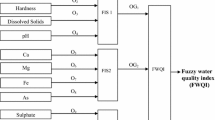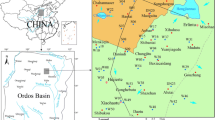Abstract
In this study, thermal groundwater from arid area in southeastern Tunisia was assessed for irrigation use. For this purpose, thirty-one water samples were collected and physiochemical parameters (EC, pH, TDS, major ions) were measured and analyzed. A fuzzy logic model was developed in which six parameters were integrated: electrical conductivity, sodium adsorption ratio, sodium percentage, Kelly ratio, permeability index and temperature. The membership functions for a fuzzy logic model were developed using linguistic terms and trapezoidal shapes. The fuzzy logic model developed was validated with a dataset of chemical analyses from groundwater sampled in the study area. The assessment indicated that 26% of the samples were in the “good” class, 10% in the “good to permissible” class, 55% are in the “permissible” class, 6% are in the “permissible to harmful” class and 3% were considered to be harmful and therefore unsuitable for use in irrigation. The effectiveness, simplicity and robustness of the fuzzy model assessment make this approach a more consistent and reliable way of assessing water quality than conventional methods of assessing water quality data.

(source Tunisian geological map 1/100,000, El Hamma Sheet)














Similar content being viewed by others
References
Agoubi B, Kharroubi A, Abida H (2013) Hydrochemistry of groundwater and its assessment for irrigation purpose in coastal Jeffara Aquifer, southeastern Tunisia. Arab J Geosci 6:1163–1172. doi:10.1007/s12517-011-0409-1
Agoubi B, Souid F, Telahigue F, Kharroubi A (2015) Temperature and radon-222 as tracer of groundwater flow: application to El Hamma geothermal aquifer system, southeastern Tunisia. Arab J Geosci. doi:10.1007/s12517-015-1998-x
Al-ahmadi ME, El-Fiky AA (2009) Hydrogeochemical evaluation of shallow alluvial aquifer of Wadi Marwani, western Saudi Arabia. J King Saud Uni 21:179–190
Allen DM, Schuurman N, Zhang Q (2007) Using fuzzy logic for modeling aquifer architecture. J Geogr Syst 9:289–310. doi:10.1007/s10109-007-0046-0
Assaf H, Saadeh M (2009) Geostatistical assessment of groundwater nitrate contamination with reflection on DRASTIC vulnerability assessment: the case of the Upper Litani Basin, Lebanon. Water Resour Manag 23:775–796
Damodha U, Reddy MV (2013) Impact of pharmaceutical industry treated effluents on the water quality of river Uppanar, South east coast of India: a case study. Appl Water Sci 3:501–514. doi:10.1007/s13201-013-0098-x
Demicco RV, Klir GJ (2004) Fuzzy logic in geology. Elsevier academic press. ISBN:0-12-415146-9
Doneen LD (1964) Notes on water quality in agriculture. Published as a water science and engineering paper 4001. Department of Water Science and Engineering, University of California
Gemitzi A, Petalas C, Tsihrintzis VA, Pisinaras V (2006) Assessment of groundwater vulnerability to pollution: a combination of GIS, fuzzy logic and decision making techniques. Environ Geol 49:653–673. doi:10.1007/s00254-005-0104-1
Ghasemi E, Amini H, Ataei M, Khalokakaei R (2014) Application of artificial intelligence techniques for predicting the flyrock distance caused by blasting operation. Arab J Geosci 7:193–202. doi:10.1007/s12517-012-0703-6
Gibbs RJ (1970) Mechanisms controlling world water chemistry. Sciences 170:1088–1090
Guendouz A, Moullaa S (2004) Estimation du taux de recharge et d’évaporation à travers la zone non saturée en zone aride: application des techniques nucléaires et hydrogéochimiques. Colloque international « terre et eau » Annaba, Algérie, 21, 22, 23 Nov 2004, pp 230–233 (in french)
Hall AE (2014) The environmental and physiological nature of heat stress. Botany and plant sciences department, University of California, Riverside. http://www.plantstress.com/articles/heat_i/heat_i.htm
Iancu I (2012) A mamdani type fuzzy logic controller. In: Dadios E (ed) Fuzzy logic-controls, concepts, theories and applications. ISBN:978-953-51-0396-7
Icaga Y (2007) Fuzzy evaluation of water quality classification. Ecol Ind 7:710–718
Kelly WP (1963) Use of saline irrigation water. Soil Sci 95(4):355–391
Khan HH, Khan A, Ahmed S, Perrin J (2011) GIS based impact assessment of land use changes on groundwater quality—study from a rapidly urbanizing region of South India. Environ Earth Sci 63:1289–1302. doi:10.1007/s12665-010-0801-2
Khan A, Umar R, Khan HH (2015) Hydrochemical characterization of groundwater in lower Kali watershed, Western UP, India. J Geol Soc India 86(2):195–210
Kharroubi A, Farhat S, Agoubi B, Lakhbir Z (2014) Assessment of water qualities and evidence of seawater intrusion in a deep confined aquifer: case of the coastal Djeffara aquifer (Southern Tunisia). J Water Supply Res Technol AQUA 63(1):62–84. doi:10.2166/aqua.2013.105
Klir GJ (2004) Fuzzy logic: a specialized tutorial, in fuzzy logic in geology. Elsevier academic press, ISBN:0-12-415146-9
Kumar SK, Bharani R, Magesh NS, Godson PS, Chandrasekar N (2014) Hydrogeochemistry and groundwater quality appraisal of part of south Chennai coastal aquifers, Tamil Nadu, India using WQI and fuzzy logic method. Appl Water Sci. doi:10.1007/s13201-013-0148-4
Mirabbasi R, Mazloumzadeh SM, Rahnama MB (2008) Evaluation of irrigation water quality using fuzzy logic. Res J Environ Sci 2(5):340–352
Muhammetoglu A, Yardimci A (2006) A fuzzy logic approach to assess groundwater pollution levels below agricultural fields. Environ Monit Assess 118:337–354. doi:10.1007/s10661-006-1497-3
Naseem S, Hamza S, Bashie E (2010) Groundwater of winder agricultural farms, Balochistan, Palistan and assessment for irrigation water quality. Eur Water 31:21–32
Nasr AS, Rezaei M, Dashti M (2012) Analysis of groundwater quality using mamdani fuzzy inference system (MFIS) in Yazd Province, Iran. Int J Comput Appl 59(7):45–53
Paliwal KV (1967) Effect of gypsum application on the quality of irrigation waters. Madras Agric J 59:646–647
Priya KL (2013) Afuzzy logic approach for irrigation water quality assessment: a case study of Karunya watershed, India. J Hydrogeol Hydrol Eng 2013(2):1. doi:10.4172/2325-9647.1000104
Richards LA (1954) In: U.S. Dep. Agr. Handbook. 60 (ed) Diagnosis and improvement of saline and alkali soils. U.S. Govt. Printing Office, Washington, D.C., p 157
Sadeghi B, Khalajmasoumi M (2015) A futuristic review for evaluation of geothermal potentials using fuzzy logic and binary index overlay in GIS environment. Renew Sustain Energy Rev 43C:818–831
Sahli H, Tagorti MA, Tlig S (2013) Groundwater hydrochemistry and mass transfer in stratified aquifers system (Jeffara Gabes basin, Tunisia). Larhyss J 12:95–108
Sarkar AA, Hassan AA (2006) Water quality assessment of a groundwater basin in Bangladesh for irrigation. Pak J Biol Sci 9(9):1648–1677
Shi Z, Li Y, Wang RC, Makeschine F (2005) Assessment of temporal and spatial variability of soil salinity in a coastal saline field. Environ Geosci 48:171–178
Silvert W (2000) Fuzzy indices of environmental conditions. Ecol Model J 130(1–3):111–119
Singh AK, Mondal GC, Tewary BK, Sinha A (2009) Major ions chemistry, solute acquisition process and quality assessment of mine water in damodar valley coalfields, India. Abstracts of the International Mine Water Conference, 19th–23rd October 2009, Pretoria, South Africa
Soares A (2010) Geostatistical methods for polluted sites characterization. In: Atkinson PM, Lloyd CD (eds) Geoenv VII-geostatistics for environmental applications. Quantitative geology and geostatistics, vol 16, pp 187–198
USSL (1954) Diagnosis and improvement of saline and alkali soils, vol 60. US Department Agric Handbook, Washington, p 160
Wilcox LV (1955) Classification and use of irrigation waters. USDA Circular No. 969, p 19
Yousif M, El Abd E, Baraka A (2013) Assessment of water resources in some drainage basins, northwestern coast, Egypt. Appl Water Sci 3:439–452. doi:10.1007/s13201-013-0093-2
Zadeh LA (1965) Fuzzy sets. Inf control J 8:338–353
Author information
Authors and Affiliations
Corresponding author
Rights and permissions
About this article
Cite this article
Agoubi, B., Souid, F., Kharroubi, A. et al. Assessment of hot groundwater in an arid area in Tunisia using geochemical and fuzzy logic approaches. Environ Earth Sci 75, 1497 (2016). https://doi.org/10.1007/s12665-016-6296-8
Received:
Accepted:
Published:
DOI: https://doi.org/10.1007/s12665-016-6296-8




